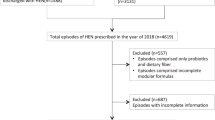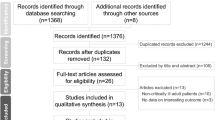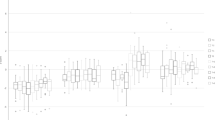Abstract
Background/Objectives:
The home enteral nutrition (HEN) provides nutritional support to children with chronic diseases who are nutritionally compromised and allows them to be discharged more quickly from hospitals. In 2003, a web-based registry (Nutrición Enteral Pediátrica Ambulatoria y Domiciliaria, Pediatric Ambulatory and Home Enteral Nutrition -NEPAD-) was created with the objective of gathering information about pediatric HEN practices in Spain.
AIM:
The aim of this study was to report the implementation of the NEPAD (Nutrición Enteral Pediátrica Ambulatoria y Domiciliaria, Pediatric Ambulatory and Home Enteral Nutrition) registry of pediatric HEN in Spain and to analyze data evolution trends from 2003 to 2010.
Subjects/Methods:
The data from the Spanish NEPAD registry were analyzed according to the following variables: demographic data, diagnosis, indication for HEN, nutritional support regime and administration route.
Results:
Over the study period, 952 patients (1048 episodes) from 20 Spanish hospitals were included in the NEPAD registry. The most frequent indication for HEN was decreased oral intake (64%), and neurological disease was the most prevalent illness. HEN was delivered via a nasogastric tube in 573 episodes (54.7%), by gastrostomy in 375 episodes (35.8%), oral feeding in 77 episodes (7.3%) and by jejunal access in 23 episodes (2.2%). Significant differences in the mode of administration were observed based on the pathology of the child (χ2, P<0.0001). The cyclic feeding was the most widely used technique for the administration of HEN. Most of the patients used a pump and a polymeric formula. Transition to oral feeding was the primary reason for discontinuation of this type of support.
Conclusions:
Since the NEPAD registry was established in Spain, the number of documented patients has increased more than 25-fold. Many children with chronic illness benefit from HEN, mainly those suffering from neurological diseases.
This is a preview of subscription content, access via your institution
Access options
Subscribe to this journal
Receive 12 print issues and online access
$259.00 per year
only $21.58 per issue
Buy this article
- Purchase on Springer Link
- Instant access to full article PDF
Prices may be subject to local taxes which are calculated during checkout





Similar content being viewed by others
References
Avitsland TL, Kristensen C, Emblem R, Veenstra M, Mala T, Bjørnland K . Percutaneous endoscopic gastrostomy in children: a safe technique with major symptom relief and high parental satisfaction. J Pediatr Gastroenterol Nutr 2006; 43: 624–628.
Martínez-Costa C, Borraz S, Benlloch C, López-Sáiz A, Sanchiz V, Brines J . Early decision of gastrostomy tube insertion in children with severe developmental disability: a current dilemma. J Hum Nutr Diet 2011; 24: 115–121.
Castelló-Botía I, Wanden-Berghe C, Sanz-Valero J . Artificial nutritional support registries: systematic review. Nutr Hosp 2009; 24: 711–716.
Annual BANS Report, 2011; Artificial Nutrition Support in the UK 2000-2010Committee of the British Association for Parenteral and Enteral Nutrition (BAPEN) 2011, (accessed May 12, 2012, at http://www.bapen.org.uk/pdfs/bans_reports/bans_report_11.pdf.
Pedrón-Giner C, Puiggrós C, Calañas A, Cuerda C, García-Luna PP, Irles JA et al. Spanish home enteral nutrition (HEN) registry of the year 2008 from the NADYA-SENPE group. Nutr Hosp 2010; 25: 725–729.
Wanden-Berghe C, Puiggrós JC, Calañas A, Cuerda C, García-Luna PP, Rabassa-Soler A et al. Grupo NADYA-SENPE. The Spanish Home Enteral Nutrition registry of the year 2009: from the NADYA-SENPE group. Nutr Hosp 2010; 25: 959–963.
Planas Vilá M, Wanden-Berghe Lozano C, Cuerda Compés MC, and NADYA-SENPE Group. Guide for Home Enteral Nutrition in the National Health System 2008, 2a edn, Madrid: Health and Consumerism Ministry. ISBN 978-84-7670-695-4.
Moreno Villares JM, Pedrón Giner C, Martínez Costa C, Oliveros Leal L, Galera Peinado AP, Rossel Camps A et al. Home enteral nutrition in Spain. Results of the register of the Spanish Society of Pediatric Gastroenterology, Hepatology and Nutrition in 2003. An Pediatr (Barc) 2006; 64: 239–243.
Salomon Zaban AL, Garbi Novaes MR . Home enteral nutrition in children: a one-year experience with 184 patients in Distrito Federal, Brazil. Exp Biol Med (Maywood) 2010; 235: 584–589.
Pironi L, Candusso M, Biondo A, Bosco A, Castaldi P, Contaldo F et alItalian Society for Parenteral and Enteral Nutrition Executive Committee. Prevalence of home artificial nutrition in Italy in 2005: a survey by the Italian Society for Parenteral and Enteral Nutrition (SINPE). Clin Nutr 2007; 26: 123–132.
Diamanti A, Pietrobattista A, Gambarara M . Home enteral nutrition in children: a 17-year period experience. Clin Nutr 2006; 25: 173–174.
Greater Metropolitan Clinical Taskforce. Home enteral nutrition network. Home enteral nutrition report 2007, (accessed December 12, 2011, at http://www.health.nsw.gov.au/gmct/hen/reports.asp).
Daveluy W, Guimber D, Mention K, Lescut D, Michaud L, Turck D et al. Home enteral nutrition in children: an 11-year experience with 416 patients. Clin Nutr 2005; 24: 48–54.
Szlagatys-Sidorkiewicz A, Popińska K, Toporowska-Kowalska E, Borkowska A, Sibilska M, Gębora-Kowalska B et al. Home enteral nutrition in children-2010 nationwide survey of the Polish Society for Clinical Nutrition of Children. Eur J Pediatr 2012; 171: 719–723.
Ganga-Zandzou PS, Hankard R, Gottrand F, Turck D, Debrabander A, Robert M et al. Home enteral nutrition in children and adolescent. Experience of 79 patients. Ann Pediatr (Paris) 1995; 42: 295–301.
Navarro J, Goutet JM, Charritat JL . Constant rate enteral feeding in the patient’s home. Clinical experience in Pediatrics (111 children). Nouv Presse Med 1980; 9: 621–623.
McCarey DW, Buchanan E, Gregory M, Clark BJ, Weaver LT . Home enteral feeding of children in the west of Scotland. Scott Med J 1996; 41: 147–149.
Castaño Escudero A, Pérez Gabarda ME . Evolution of home-based enteral nutrition in Madrid 2002-2007. Nutr Hosp 2009; 24: 218–225.
Cuerda Compés MC . Home-based enteral nutrition. Nutr Hosp 2009; 24: 111–112.
Olveira G, Tapia MJ, Colomo N, Muñoz A, Gonzalo M, C-Soriguer F . Usefulness of the daily defined dose method to estimate trends in the consumption, costs and prevalence of the use of home enteral nutrition. Clin Nutr 2009; 28: 285–290.
Wanden-Berghe C, Sanz-Valero J, Culebras J, Red de Malnutrición en Iberoamérica Red MeI-CYTED. Information in home nutrition: the importance of the registries. Nutr Hosp 2008; 23: 220–225.
Daveluy W, Guimber D, Uhlen S, Lescut D, Michaud L, Turck D et al. Dramatic changes in home-based enteral nutrition practices in children during an 11-year period. J Pediatr Gastroenterol Nutr 2006; 43: 240–244.
Santini B, Savino F, Ivaldi AP, Ferrero L, Canova A, Madon F . Home enteral nutrition in pediatric age. Based on the Torino experience. Minerva Pediatr 1996; 48: 429–437.
Ganga-Zandzou PS, Bourgois B, Mars A, Pouessel G, Flammarion S, Cixous E et al. Home-based enteral nutrition with percutaneous endoscopic gastrostomy. Experience in children at Roubaix. Arch Pediatr 2011; 18: 459–460.
Gauderer MW, Ponsky JL, Izant RJ . Gastrostomy without laparotomy: a percutaneous endoscopic technique. J Pediatr Surg 1980; 15: 872–875.
Marchand V, Motil KJ, NASPGHAN Committee on Nutrition. Nutrition support for neurologically impaired children: a clinical report of the North American Society for Pediatric Gastroenterology. J Pediatr Gastroenterol Nutr 2006; 43: 123–135.
Samson-Fang L, Butler C, O′Donnell M, AACPDM. Effects of gastrostomy feeding in children with cerebral palsy: an AACPDM evidence report. Dev Med Child Neurol 2003; 45: 415–426.
Sullivan PB, Lambert B, Rose M, Ford-Adams M, Johnson A, Griffiths P . Prevalence and severity of feeding and nutritional problems in children with neurological impairment: Oxford Feeding Study. Dev Med Child Neurol 2000; 42: 674–680.
Virnig DJ, Frech EJ, Delegge MH, Fang JC . Direct percutaneous endoscopic jejunostomy: a case series in pediatric patients. Gastrointest Endosc 2008; 67: 984–987.
Cuerda C, Planas M, Gómez Candela C, Luengo LM, NADYA-SENPE group. Trends in home enteral nutrition in Spain: analysis of the NADYA registry 1992-2007. Nutr Hosp 2009; 24: 347–353.
Author information
Authors and Affiliations
Corresponding author
Ethics declarations
Competing interests
The authors declare no conflict of interest.
Additional information
Supplementary Information accompanies the paper on European Journal of Clinical Nutrition website
Supplementary information
Rights and permissions
About this article
Cite this article
Pedrón-Giner, C., Navas-López, V., Martínez-Zazo, A. et al. Analysis of the Spanish national registry for pediatric home enteral nutrition (NEPAD): implementation rates and observed trends during the past 8 years. Eur J Clin Nutr 67, 318–323 (2013). https://doi.org/10.1038/ejcn.2013.8
Received:
Revised:
Accepted:
Published:
Issue Date:
DOI: https://doi.org/10.1038/ejcn.2013.8
Keywords
This article is cited by
-
Weaning children from prolonged enteral nutrition: A position paper
European Journal of Clinical Nutrition (2022)
-
Behandlung von Sondendependenz bei Kindern
Monatsschrift Kinderheilkunde (2020)



